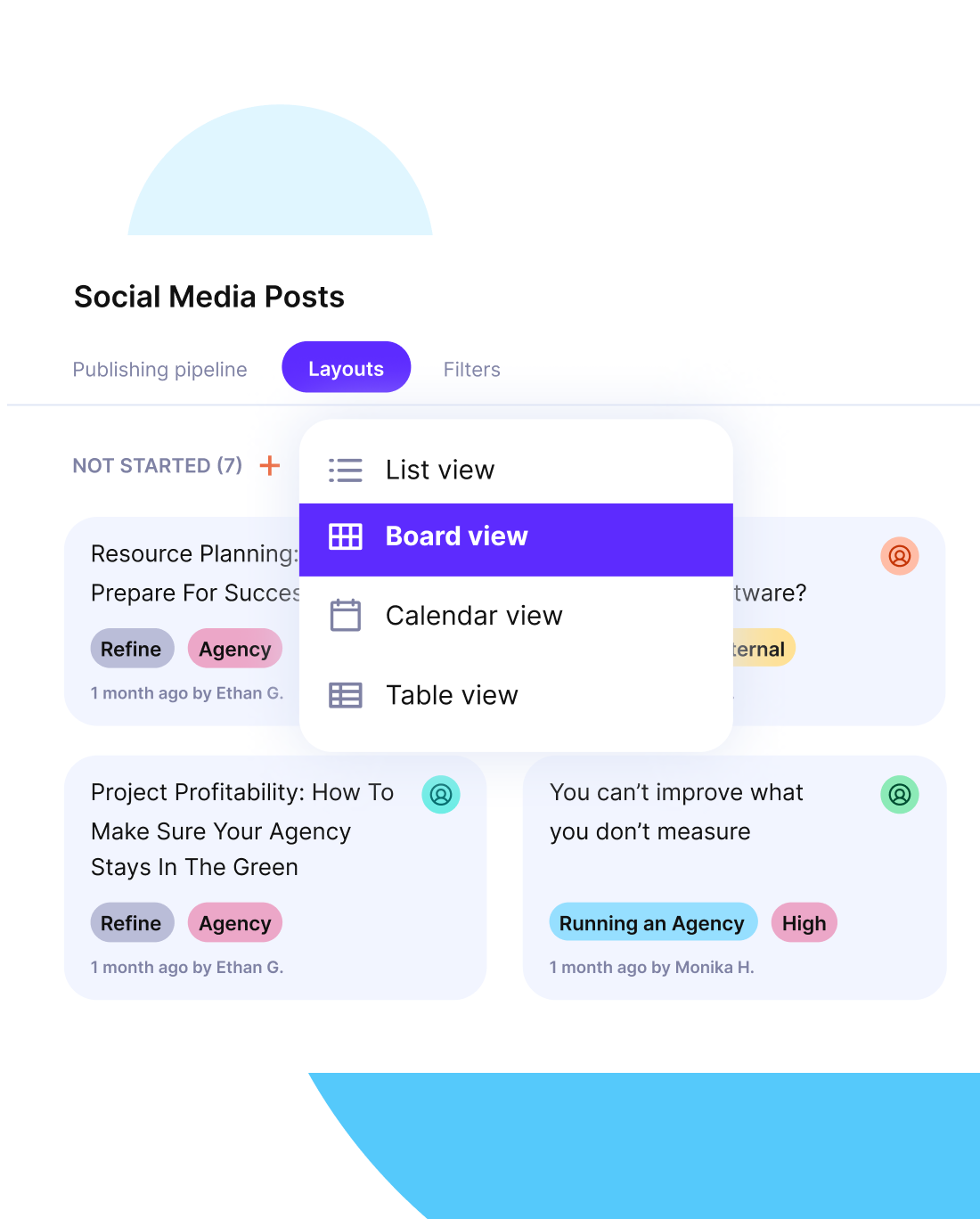Risk Management in Project Management: Step-by-Step Guide
Risk management in project management helps you spot problems before they derail your work. It’s a practical way to avoid unnecessary delays and cost overruns.
Done right, it helps teams spot risks early, protect their resources, and deliver on time.
In this guide, you’ll learn how to manage risks in projects with actionable steps, practical examples, recommended tools, and best practices you should always stick with.
Key Takeaways
- A clear risk management process helps you prevent delays, cost overruns, and miscommunication.
- Risk identification, assessment, response, and control are essential steps for staying ahead of issues.
- The right tools, like integrated risk registers and dashboards, make ongoing tracking easier and more reliable.
- Connecting risk tracking with financial and resource planning leads to better project outcomes and higher profitability.
What Is Risk Management in Project Management?
Project risk management is the process of identifying, analyzing, and controlling possible risks to reduce their negative impact. In project management, this means staying alert to anything that could derail your goals, like a delayed deliverable or a sudden change in client expectations.
This process, often called risk control, is central to project risk management because it gives project teams a proactive way to address uncertainty.
Types of Project Risks
Project risks can include scope creep, budget overruns, missed deadlines, resource shortages, and unexpected stakeholder changes. These issues affect project performance in different ways depending on their root causes.
Below is a simple table that outlines common project risks, why they happen, and their potential impact:
| Risk Events | Why It Happens? | Risk Impact |
|---|---|---|
| Scope creep | Poorly defined requirements or frequent changes | Missed deadlines, budget overruns |
| Budget overruns | Inaccurate estimates, scope changes, rework | Reduced profitability, funding issues |
| Missed deadlines | Overambitious planning, resource bottlenecks | Delayed delivery, client dissatisfaction |
| Resource shortages | Poor capacity planning or team overbooking | Task delays, overworked staff |
| Stakeholder changes | Leadership turnover or shifting priorities | Conflicting expectations, rework |
Why Is Risk Management Important in Projects?
Risk management is important because it helps projects stay on time, on budget, and aligned with scope. When you flag potential issues early, you’re less likely to scramble at the last minute or waste time and resources fixing preventable problems.
It also gives your stakeholders a clearer view of what’s going on and helps your leadership team make smarter, faster decisions.
Project Management Institute’s 2025 Pulse Report found that only 58% of projects were completed within budget and 52% within schedule. The obvious conclusion is that unmanaged risks lead to costly outcomes.
Keep in mind that risks can also be a good thing, we talk about those in our positive risks guide.
What Are the Benefits of Risk Management in Project Management?
The benefits of risk management in project management are fewer delays, more predictable delivery, and stronger stakeholder confidence.
Better control over risks leads to higher project success. When you manage risks properly, you avoid unnecessary delays, communicate more clearly, and keep your team focused on the right priorities.
In case you were still wondering if risk management is an important part of project management, the answer is a hard yes.
What Are the Key Steps in the Risk Management Process?
The key steps in the risk management process are identifying, assessing, responding to, and monitoring risks throughout the lifecycle of a project. Each step builds on the last to help you stay ahead of issues before they escalate.
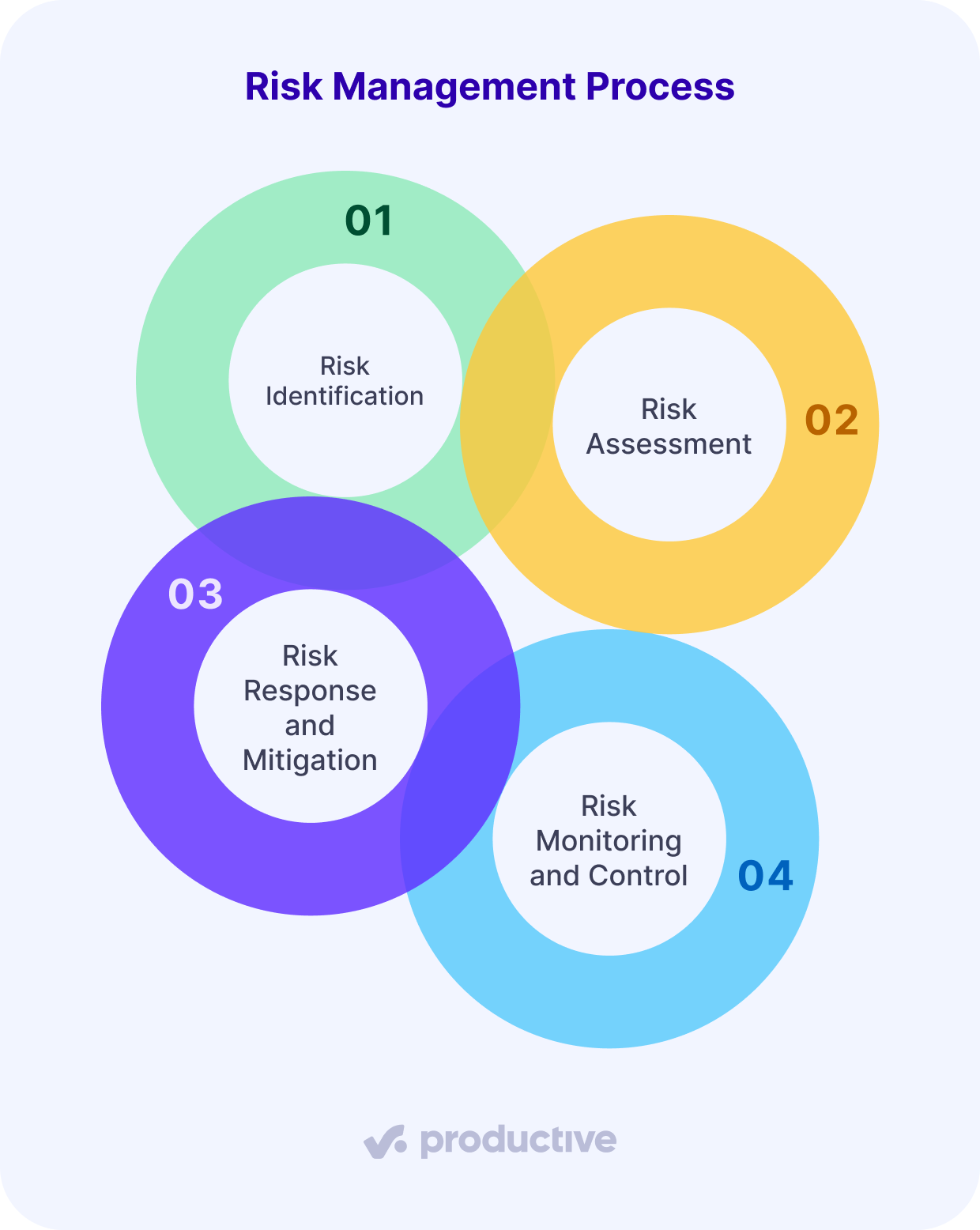
Step 1: Risk Identification
Risk identification means spotting potential risks before they escalate into real problems. This is the first and arguably most important step in keeping your project on track.
For example, you might flag a delayed supplier delivery or signs of scope creep as early risks. These issues can snowball quickly if ignored.
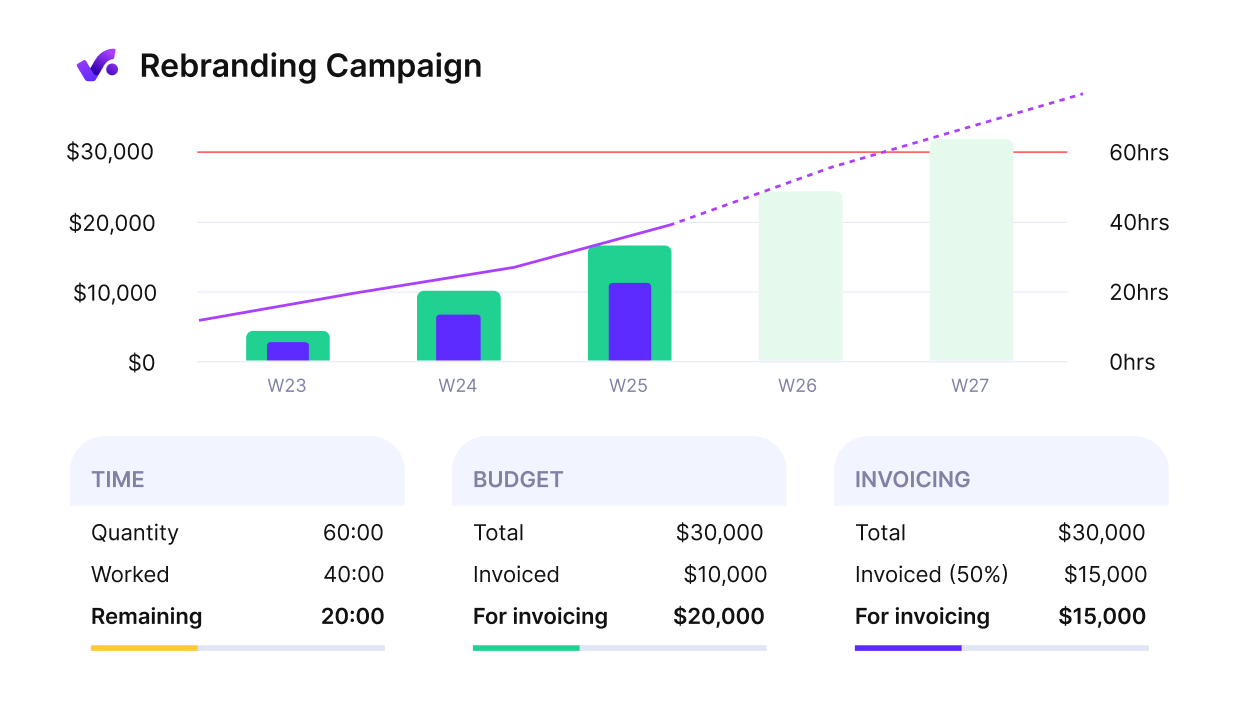
Productive gives you an early warning of budget overruns and financial risk.
To do this effectively, use a mix of brainstorming sessions, historical project data, and input from stakeholders. The more sources you pull from, the better your risk identification will be.
Step 2: Risk Assessment
Risk assessment is the step where you analyze how likely every risk event is to happen and how big an impact it might have. This helps you figure out which risks need immediate attention and which ones are less urgent.
There are two common approaches to risk analysis. In qualitative risk analysis, you rank risks subjectively, typically as high, medium, or low. In quantitative risk analysis, you take a numerical approach, estimating things like financial impact or time lost.
A typical example is assigning risk scores in a matrix that weighs both the probability and the impact of each risk. This makes it easier to prioritize and focus your risk management strategies.
Step 3: Risk Response and Mitigation
Risk responses and mitigation involve creating actions that reduce the impact of potential risks. Once you’ve assessed and prioritized risks, you need to decide how you’ll handle them.
This is where risk mitigation strategies come in. You can choose to avoid the risk entirely, transfer it to a third party, reduce its likelihood or impact, or accept it if the consequences are manageable.
For example, hiring an extra vendor to handle a time-sensitive task is one way to mitigate supply chain risks. A risk response plan helps ensure your mitigation actions are timely and effective, so your project team isn’t caught off guard when something goes sideways.
Manage project risks with Productive
Step 4: Risk Monitoring and Control
Risk monitoring and control is the ongoing process of tracking risks, reviewing their status, and adjusting your response as needed. It keeps your team informed and your mitigation plans relevant as project conditions change.
To stay proactive, you’ll want to use tools like a risk register, visual dashboards, and a documented contingency plan. For example, holding weekly project review meetings with an updated risk log helps surface new issues, monitor existing ones, and clarify risk ownership.
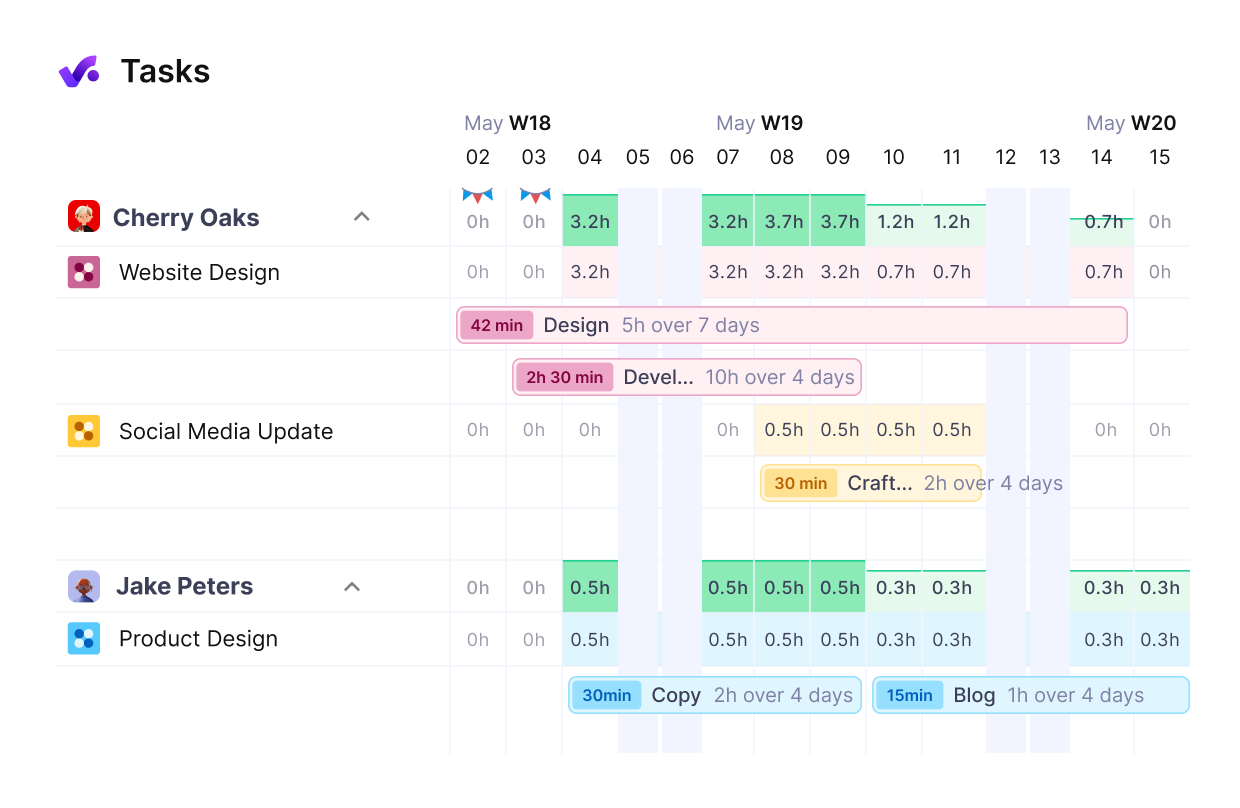
Get a real-time overview of your team’s workloads across projects.
What Are the Best Practices For Managing Risks?
The best practices for managing risks are consistent identification, prioritization, and early intervention throughout the entire project lifecycle. Below, we break down the top five risk management practices and how to implement them.

1. Use a Shared Risk Log for Ongoing Visibility
Track risks in one place where everyone on the team has access. In Productive, you can document known risks and assign owners through Live Docs or tasks, ensuring visibility and accountability across the team. This improves your ability to monitor risk status, update response actions, and avoid missing critical issues.
How to implement:
Create a shared Live Doc for each project that includes a risk tracking section. Add any known or emerging risks, assign an owner, and set review dates. Use task comments and status updates to log changes or mitigation steps.
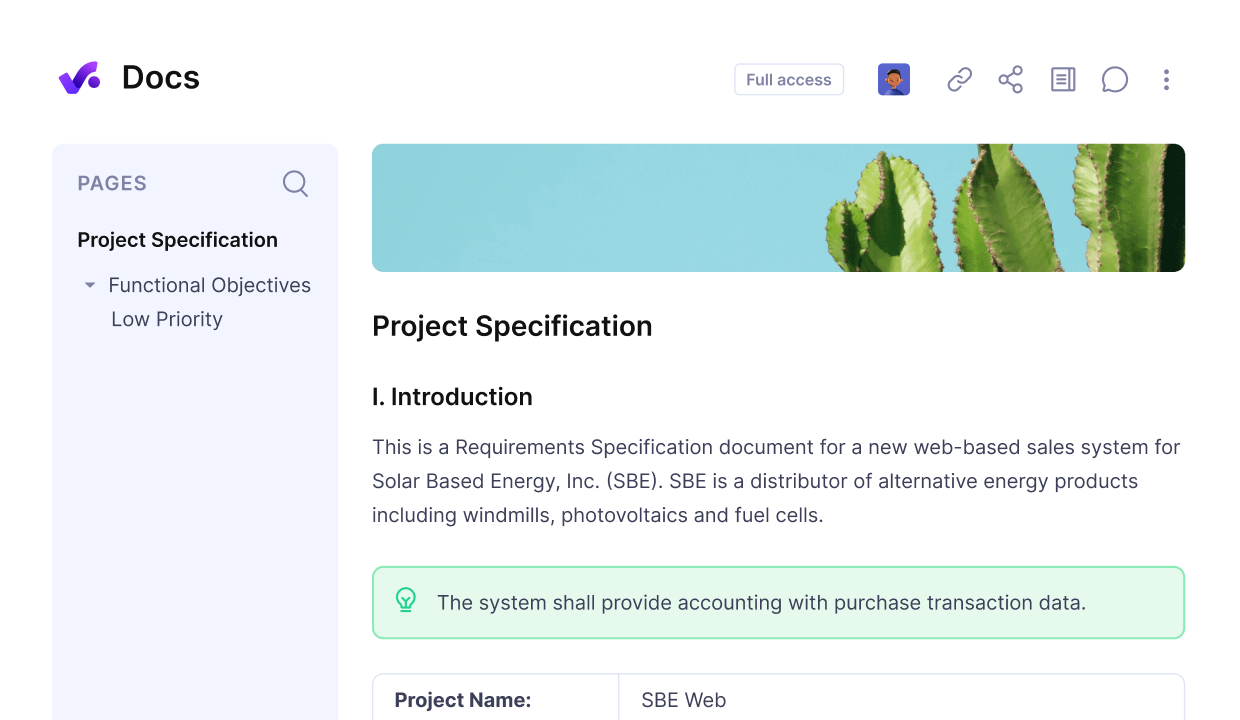
Document possible internal and external risks, draft your risk mitigation plans and share it with your team.
2. Prioritize Risks Using Real Data
Not all risks deserve equal attention. Use a simple scoring system to rank risks based on how likely they are to happen and how much impact they could have. This makes it easier to focus your time and resources on the issues that could do the most damage.
In Productive, you can spot signs of potential risk, such as overbooked team members or overlapping deadlines, by reviewing the Scheduling and Planning views.
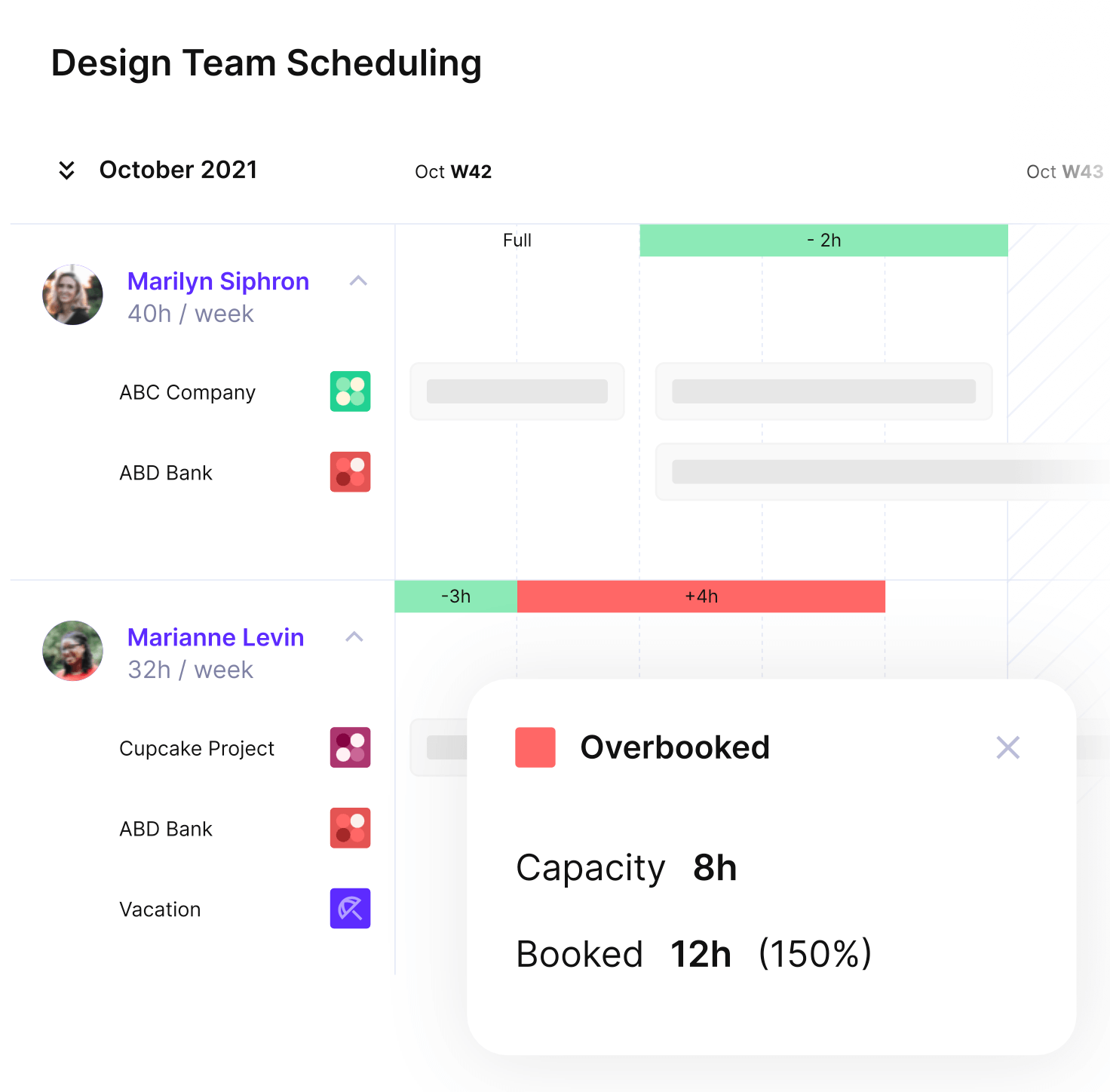
Get a real-time overview of your actual team capacity and forecast possible overbookings.
How to implement:
Use a risk scoring template in your Live Doc or spreadsheet. Score each risk based on likelihood and impact (e.g., 1–5 scale). Review scores weekly and focus first on those rated high in both dimensions.
Cross-check those with workload and scheduling data in Productive to see if capacity or timing might amplify the risk.
3. Review Risks During Weekly Planning
Include risk reviews in your weekly planning or sprint sessions to keep issues from slipping under the radar. By consistently revisiting flagged risks and their mitigation steps, you improve follow-through and reduce the chances of being blindsided by avoidable problems.
How to implement:
Add a recurring agenda item for risk review in your team’s weekly meeting. Use your Live Doc to check which risks are still open, confirm if owners have taken action, and make updates directly in the meeting.
4. Connect Risks to Tasks, Budgets, and Capacity
Risks don’t exist in a vacuum. Use your project tool to link risk signals (like missing estimates or overbooked teams) back to actual task delivery and budget impact.
Productive makes this easy with real-time capacity tracking and budget overrun alerts.

Use Productive to get real-time reports on project progress and remaining budgets.
5. Assign Clear Risk Owners
Every major risk should have a clear owner. This person isn’t responsible for causing the issue, but they are responsible for monitoring it and speaking up if things get worse. Assigning ownership ensures that risks don’t go untracked and that someone is always accountable for following up.
How to implement:
In Productive, add the owner directly in the relevant task or Live Doc section. Tag them in comments, set reminders for updates, and review ownership status in weekly team check-ins.
What Are the Common Challenges of Managing Project Risks + How To Solve Them?
Managing project risks isn’t always straightforward. Some of the most common challenges include poor visibility, lack of prioritization, unclear accountability, and disconnected planning.
Below, we’ll break down each challenge, explain why it happens and what it affects, and offer actionable ways you can fix it.
Relying on Outdated or Disconnected Data
When your team tracks risks across spreadsheets, Slack threads, and separate tools, no one has a clear picture of what’s actually at stake. As a result, risks get missed or discovered too late to prevent real damage.
Example: Your team overbooks resources for two critical projects because capacity data isn’t synced with project timelines. A risk that could’ve been avoided ends up delaying both launches.
How to solve it: Use a platform that combines project planning with live capacity and financial data. In Productive, you can quickly spot overbooked schedules, budget overruns, and timeline clashes all in one place.
Lack of Effective Prioritization
If every risk feels urgent, your team won’t know where to focus. Treating all risks the same makes it harder to manage actual threats.
Example: You spend time addressing a minor documentation delay while ignoring a high-likelihood client approval bottleneck that ends up stalling the entire project.
How to solve it: Score risks based on likelihood and impact. Use this to create a simple risk matrix and review it weekly. Prioritize items that score high on both axes.
Skipping Risk Reviews Until It’s Too Late
Many teams plan for risks once, then never revisit them. But as your project evolves, new risks can pop up while existing ones shift in impact or urgency.
Example: Your project plan doesn’t include a review checkpoint for dependencies. Halfway through, a key vendor falls behind, but no one flags the issue until the delay affects delivery.
How to solve it: Add risk review checkpoints to your weekly meetings. In Productive, use Live Docs to review and update open risks and assign follow-up tasks as needed.
Not Assigning Risk Owners
When no one owns a risk, no one monitors it. That makes it easy for critical risks to be forgotten until they explode into real issues.
Example: A project manager logs a risk but assumes someone else is tracking it. No one acts, and the issue leads to rework and budget overruns.
How to solve it: Assign each risk to a specific owner with clear responsibility. In Productive, you can tag owners in tasks or Live Docs and set reminders to follow up.
Not Linking Risks To Deliverables or Budgets
Risks that live in isolation from the work they affect are harder to track and manage.
Example: You identify a scope risk but don’t link it to the impacted deliverables. Team members keep working based on outdated assumptions, causing unnecessary rework.
How to solve it: Connect risks to the work they impact. In a project management software like Productive, you can track risk signals like overservicing, timeline delays, or missed milestones directly through budgets and task dependencies.
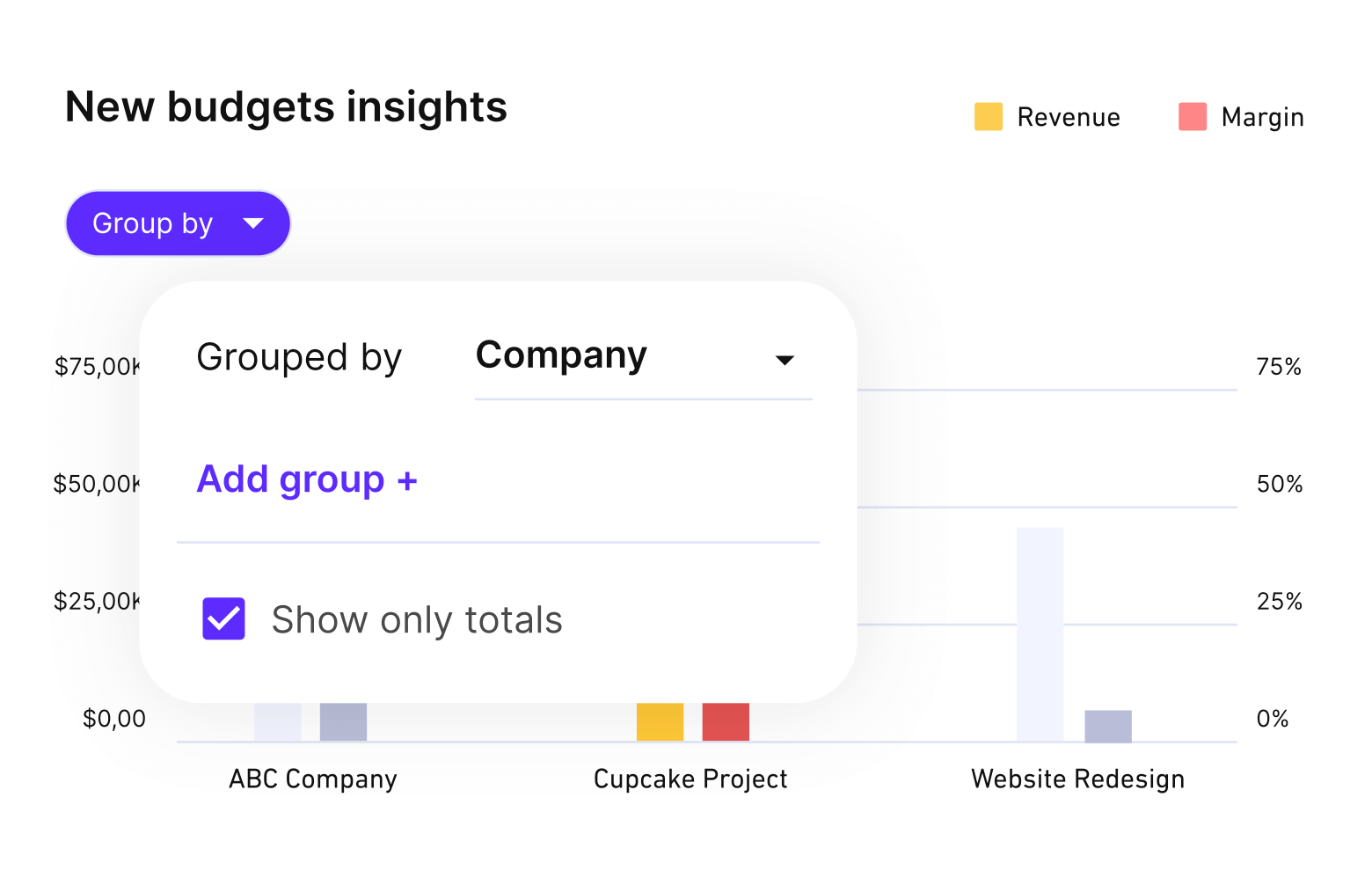
Get real-time updates on project budges and reduce financial risks.
What Tools Support Risk Management in Project Management?
The best tools for risk management in project management are platforms that help you track, assess, and respond to risks in real time. You should look for software that includes a centralized risk register, visual dashboards for reporting, and support for building a clear project risk management plan.
Here are key features your risk management tool should include:
- Centralized Risk Register: A shared space to log, categorize, and update all project risks.
- Dashboards and Visual Reporting: Easy-to-read views that show current risk exposure and status across projects.
- Contingency Planning Support: Ability to attach fallback actions or mitigation plans to individual risks.
- Task and Dependency Tracking: So you can see how each risk affects downstream work.
- Team Collaboration: Real-time commenting, notifications, and ownership assignment.
- Integration with Financials and Schedules: For a full view of how specific actions on tasks (e.g., spending too much time on rework) impact budgets and timelines.
- Audit Trails and Change Logs: To track when risks are updated, resolved, or escalated.
While Productive doesn’t have a traditional risk register, it gives you visibility into potential risks by surfacing early warnings, such as budget overruns or lack of available capacity.
You can also use Live Docs and tasks to flag and track risk-related actions within ongoing work. This means your team can manage project risk as part of your daily workflow, not in a separate spreadsheet or disconnected system.

Manage your resources and capacity in a single platform.
Final Takeaway
Risk management in project management gives you a clear view of what could go wrong and helps you act before issues escalate. With a solid risk management plan, you spend less time reacting and more time focusing on what drives project success: hitting deadlines, protecting budgets, and keeping work on track.
Tools like Productive make it easier to uncover potential threats early, monitor key metrics in real time, and act before issues become blockers.
Book a demo to find out how to connect risk tracking with planning and increase profitability.
Reduce and Mitigate Project Risks with Productive
Most risks go unmanaged because they’re buried in spreadsheets or siloed tools. Productive integrates risk signals directly into your workflows, so you can spot issues before they escalate.
